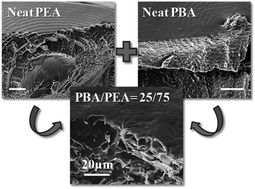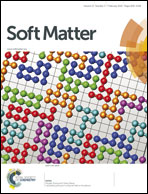Intertwining lamellar assembly in porous spherulites composed of two ring-banded poly(ethylene adipate) and poly(butylene adipate)†
Abstract
Poly(1,4-butylene adipate) (PBA) and poly(ethylene adipate) (PEA), each with the ability to form ring-banded morphologies at same Tc, were simultaneously crystallized from mixtures of various compositions. Investigations on morphology, phase and thermal behavior were conducted in order to reveal lamellar packing and spherulitic structures in this binary system. As PBA is faster-crystallizing and dominates the crystallization process, it is relatively easy to maintain its ordered ring-banded pattern in a PBA/PEA blend when there is a moderate amount of PBA in the composition (40 wt% or greater). On the other hand, PEA is much slower crystallizing and it has to be in extreme majority (PEA > 95 wt%) in the PBA/PEA mixtures in order to crystallize into ring-banded spherulites of PEA pattern. When PBA composition is between 10 and 40 wt% in the PBA/PEA blend, simultaneous crystallization of PBA and PEA leads to an interpenetrating morphology with an interwoven bird-nest pattern. Porous structures with crevices, owing to the interpenetrating PBA and PEA lamellae, resulted in simultaneous crystallization of these two biodegradable polyesters.


 Please wait while we load your content...
Please wait while we load your content...